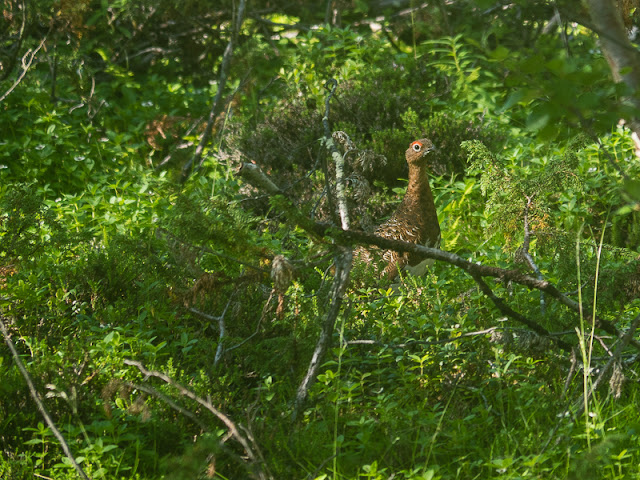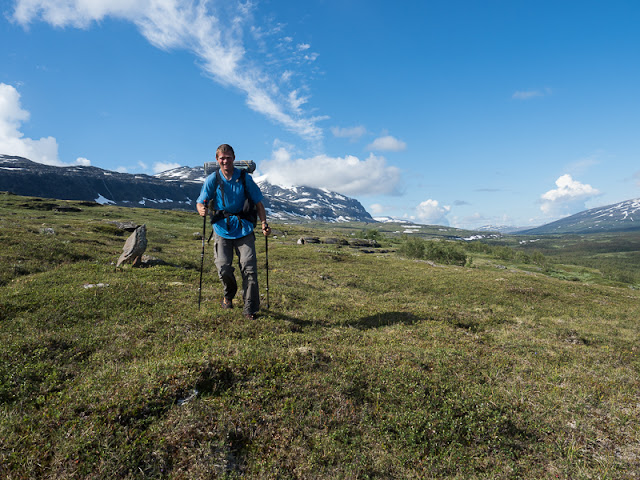On this stage I have a very interesting encounter with the members of a scientific project on the effects of climate change in the arctic.
I camp near the obviously very popular Akkastugorna, which is too busy for my taste, and continue my walk next morning along the shore of the mighty Akkajaure. The vegetation here is almost tropical lush, with lots of flowers, dense birch forest, the first blueberries and thick mosses. Occasionally I get a glimpse of the artificial lake.
Dense vegetation on the shore of Akkajaure
Angelicas have just started to flower. There is a good number of nice information boards, designed for children, from which one is able to learn that many parts of the huge plant are edible, why it was quite important for the Sami kitchen.
Angelica attracts lots of insects
In the sami village Vaisaluokta I meet two fishermen. I would be interested how life is here, but the old guys don't speak english.
There is a tiny chapel with a moss covered roof, where this evening a musician from Stockholm will play a concert. In Vaisaluokta I join the Nordkalottleden again, which I left for my Sarek detour.
Chapelkota in VaisaluoktaThere is a lot of information offered, interestingly even a sami poem, mourning the destruction of nature, closely tied with the dam building which must have altered the landscape a lot.
Sami poem
While I have a long break, taking in all the information offered, another hiker shows up. From his appearance, wearing a tiny rucksack and trailrunning shoes, I am sure that he is an experienced long distance hiker. And right so! Markus from Hamburg has already hiked many of the famous trails in the USA, and now attempts to walk from Nordkapp back home! We enjoy the company of another likeminded human so much, that we sit and talk for long time. And Markus indeed has an interesting life, turning from a well paid clerk to a part time trucker, living in a trailer and travelling whenever possible...
Meeting a likeminded german hiker
After Vaisaluokta the trail becomes much less used, because most hikers take the boat to Ritsem and continue from there, so I meet nobody again...
In the afternoon I leave the lake at a rocky shore and continue inland across big swamps and low birch forest. Unlike Norway there are a good number of boardwalks here, so my feet stay unusual dry...
Crossing vast swamps
View back to the Akka- Mountains
Once I meet a willow ptarmigan with 7 large young ones, who are already able to fly. Summer has moved on...
Willow ptarmigan
Although there are some mosquitoes around, I use the warm weather to wash me and my clothes in the river where I make camp.
Later I take off for a long evening stroll, enjoying the beauty and vastness of this wilderness of lakes, birch forests, dry hills and large moors. Sapmi summer at its best, although the first leaves turn yellow and the moss smells like autumn. It doesn't rain where I walk, but beautiful rainbows form and stay for a long time.
Late summer evening
The rainbow is mirrored in the river
Next morning the beautiful weather continues. For a long time I walk again across the endless birch forests but finally I get above timberline where fine views over these vast open spaces open. I love this wide landscape!
Vast open spaces
Walking in dry tundra
In the afternoon big, puffy clouds build up, and it doesn't take to long before it starts to rain. I change from T-Shirt to raingear and use my umbrella as well!
The big clouds bring rain
So far I have met nobody today, therefore I am quite surprised to see a group of people in an area full of coloured flags in the ground. I greet them joking: "Thanks that you have marked the minefield here". But of cause, there are no landmines but an archaeological site! The leader of the excavations Mr. Aronsson from the Sami- and mountain museum in Jokkmokk takes a lot of time to answer all my curious questions. What he explains opens my eyes in many ways:
This research is part of a project called HUMANOR, which takes a look on man and animal relations under the climate change. The geographical scale of HUMANOR reaches from Scandinavia to Mongolia and Siberia!
Here on this site a 1000 year old Sami dwelling is excavated. It was probably chosen strategically for its easy access to the nearby coast, where even at that time a lot of trade with the vikings took place. While they stayed mostly near the shore the Sami rather lived further inland, but in hard times turned to fishing at the coast. The relationship between the different cultures was peaceful, the Norwegian Sagas even tell about a sami girl who was married to a Viking chieftain!
Pollen analysis has revealed, that 1000 year ago there was forest growing here, even Pines! But then the climate got harsher and only mosses and lichen could survive the tough conditions. Just 20 years ago dwarf birches and willows started to colonialise the site again, and now even the first birches show up. Today there are quite a lot of Moose around, who feed on the new vegetation, something unheard of just a short while ago! But while the arctic climate in general gets milder, there is a paradox which causes many problems: The winters are much warmer than before, but bring more snow! In real deep winter temperatures it does not snow! The masses of the white stuff melt slowly, therefore spring comes much later than it used to. Mr. Aronsson tells, that in former times there was a late summer once in ten years, but now every third summer is late, but there never summer was as late as this year! Even Mr. Aronsson's 86 year old neighbour in Jokkmokk has never witnessed such late advent of the warm season! The mountains now in August look like they normally do in June! Usually the mosquitos appear at midsummer, but this year that was a whole month later! As many birds rely on them to feed their offspring in June, this is a catastrophy for them!
I tell Mr. Aronsson about my observation that I think there were many more birds in Lapland 20 years ago, which he thinks is absolutely correct!
Even for the Lemmings which normally survive easily the winters under the snow, this abnormal length of winter is too much, so their numbers drop as well, with terrible consequences on their predators!
I was already aware that this is an unusual summer, but just now I realise how bad the ecological consequences are!
But anyway, reindeer herders in Scandinavia are better off than their colleagues in Siberia, because here they can give their animals emergency food in hard times. This is not possible in areas with no infrastructure, like on the Jamal Peninsula in Siberia. Not long ago, when rain fell in winter and then froze solid, in a short period of time 60.000 reindeer died, leaving the Nenet herders impoverished!
Mr. Aronsson, the director of a
very interesting scientific project
While we chat, the rain ends after an hour and the sun soon is out again!
I say goodbye and continue walking towards the Norwegian border, which I finally cross. In a fantastic Granite landscape, the familiar red T- markings are back again.
Back in Norway
A fantastic Granite landscape
I have reached the upper part of the deep Hellemo Canyon. As the granite here is smooth and partly steep, I need some time to find a suitable route to get to the other side, where I pitch camp on the moss between the granite slabs.
Camp above Hellemo Canyon
This spectacular camp sets another highlight on a very interesting day! I am very happy to be here!
Magical evening





















Keine Kommentare:
Kommentar veröffentlichen